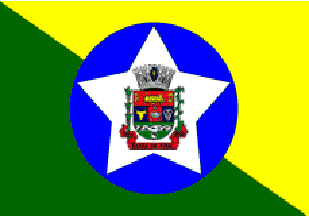 image by Ivan Sache, 7
March 2012
image by Ivan Sache, 7
March 2012Source: http://www.pmbp.rj.gov.br/index.php?option=com_content&view=article&id=55&Itemid=56

Last modified: 2012-04-07 by ian macdonald
Keywords: rio de janeiro | barra do piraí |
Links: FOTW homepage |
search |
disclaimer and copyright |
write us |
mirrors
 image by Ivan Sache, 7
March 2012
image by Ivan Sache, 7
March 2012
Source:
http://www.pmbp.rj.gov.br/index.php?option=com_content&view=article&id=55&Itemid=56
Yellow over green divided on a descending diagonal, overall a large blue disk bearing a large white star with the municipal arms in the center.
The municipality of Barra do Piraí (103,834 inhabitants in 2010; 578 sq. km) is located in southeastern Rio de Janeiro State, 100 km of Rio de Janeiro. The municipality is made of the town of Barra do Piraí proper and of the districts of Ipiabas, Vargem Alegre, Dorândia, São José do Turvo and Califórnia da Barra.
Barra do Piraí was settled in 1761-1765 on land owned near the confluence ("barra") of rivers Piraí and Paraíba do Sul by Antônio Pinto de Miranda and Francisco Pernes Lisboa. The first colonists belonged to the Faro and Pereira da Siva families, soon the main producers of coffee in the region. In 1853, the lands situated on each side of the Piraí were eventually linked by a bridge built by Gonçalves Morais. The small settlement of Santana was established by João Pereira da Silva and José de Pereira de Faro, later the Baron of Rio Bonito. The place became a main place of trade, so that a railway station was inaugurated on 7 August 1864, with lines subsequently branching to Minas Gerais and São Paulo. Barra do Piraí was emancipated by Decree No. 59 of 10 March 1890, being the first town emancipated by the Republican regime. Emancipation was granted by José de Pereira de Faro, the 3rd Baron of Rio Bonito.
The coat of arms of Barra do Piraí was designed by Pr. Alberto Lima. The coat of arms is "Tierced per fess, 1. Gules a locomotive ('The Baroness') or surrounded dexter with a letter "P" or sinister with the Roman numeral "II" or, 2a. Azure a bovine's head or, 2b. Gules a Baron's coronet argent in chief a star of the same in base two stars per fess of the same, 2c. Azure a cog wheel argent over a caduceus of the same, 3. Vert a fess argent wavy azure a pale of the same, symbolizing the toponym 'Barra do Piraí'. A scroll gules inscribed in letters argent "1864 - BARRA DO PIRAÍ - 1890. The shield supported dexter by a branch of coffee proper and sinister by a plant of sugarcane proper. The shield surmounted by a five-towered mural crown argent, the symbol of a 'cidade', charged with an oval azure charged with a fleur-de-lis or."
The Portuguese shield recalls the Lusitanian origin of the country. The "Baroness" locomotive and the monogram "P II" recall the arrival in Barro do Piraí on 7 August 1864 of the first train of the Brazilian Central Railways (then named for emperor Peter II). The bovine's head represents cattle-breeding. The Baron's coronet recalls the famous José Pereira de Faro, while the no less famous patriots José Pereira da Silva, the Moraes and the Breves are represented by the stars. The cog wheel and caduceus represent industry and commerce, respectively. The fess wavy represents river Paraíba do Sul while the pale wavy represents River Piraí, the origin of the name of the municipality. Coffee and sugarcane are the two crops that most contributed to the economic development. The fleur-de-lis symbolizes St. Ann, the patron saint of the town. The years "1864" and "1890" represent the beginning of the struggle and the eventual municipal emancipation, Barro do Piraí having been made a "cidade" and municipality by Decree No. 59 of 10 March 1890.
Or represents force, argent represents candor, gules represents
intrepidness, azure represents serenity and vert represents abundance.
Ivan Sache, 7 March 2012
http://www.pmbp.rj.gov.br/index.php?option=com_content&view=article&id=55&Itemid=56 - Municipal website (new source)
Anything below the following line isnt part of the Flags of the World Website and was added by the hoster of this mirror.
Bei fahnenversand.de erhalten Sie eine Vielzahl an günstigen Flaggen, Pins und Aufnähern, zum Beispiel:




